Use index to navigate page
![]()
What is Career Tracks
Career Tracks is a new framework and job architecture that aligns jobs to respective labor markets by occupation. Career Tracks enables UC to define job titles consistently within each location and across the university. Levels for professional (individual contributor), supervisory and management roles are defined consistently across occupations for comparable jobs. Career Tracks makes it easier for employees to identify and develop career paths and contains well defined job standards that will replace the outdated Series Concepts and Classification Specifications for policy-covered jobs.
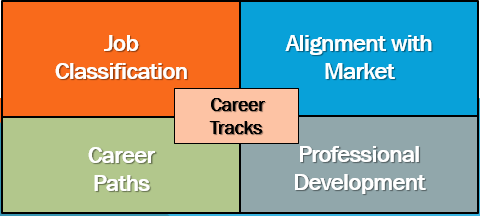
Career Tracks has many benefits for employees and managers, including:
- It gives employees better-defined career paths within their job functions
- As a systemwide program, employees can see how to advance their career at any UC location
- Job titles reflect primary job responsibilities, supporting efforts to recruit and retain qualified employees, and are aligned with pay practices in the local labor market
- With salary ranges reflecting the local market, managers can make better pay decisions
Career tracks will not affect individual job duties or functions, working title (business card) or individual salary.
![]()
Origin of Career Tracks
In the late 1990’s, UC Berkeley determined that the current UC classification system presented many challenges - job titles were generic and did not reflect the employee’s occupation; classifications were not easily comparable to the outside labor market; career paths were difficult to plan; and employee development plans were not always linked to common job requirements in a systematic way. They also determined that in order to identify the appropriate compensation levels for campus jobs, those jobs must be organized in a structure that could be compared to similar jobs in both higher education and other non-profit and private sector organizations.
After several years of research, extensive campus involvement, guidance from external professional consultation services, and job structure design, a new classification system called Career Compass was implemented in 2009. Career Compass accomplished the following results:
- Job Titles are more specific, reflecting occupational distinctions in the market, allowing sensitivity to market pay rates (external equity)
- Career Compass levels (Professional levels 1-5, Supervisory levels 1-2, Managerial levels 1-4) provide for internal equity
- The Knowledge and Skills sections of job standards are used for Recruitment, Performance Management, and Career Development
- The structure provides clear level distinctions and the Generic Scope allows for consistency across job families
After recognizing the success of Career Compass at UC Berkeley, the UC Office of the President determined that the rest of the system would greatly benefit from a similar system and so the development of Career Tracks began. Career Tracks was built largely upon the Career Compass structure and has been modified to fit all UC campuses. Career Tracks is a work-in-progress and thus not all job families and functions have been completely finished. A major effort to create health care families and functions is currently underway.
![]()
Moving to Career Tracks
Moving to Career Tracks is a systemwide initiative and strongly endorsed by UC President Napolitano. Here are some reasons why UCSB was excited about moving to Career Tracks:
- The legacy classification framework (series concepts and classification specifications) was over 40 years old and not consistently applied across the UC system.
- The legacy framework didn’t provide a balanced approach to classifying and paying positions – it relied too heavily on applying institutional factors (complexity, impact, scope, resources, supervision) and didn’t include aligning pay with the labor market.
- Career advancement and promotional job tracks were unclear in the legacy structure to current and prospective employees.
- Use of generic titles, such as Student Affairs Officer, Analyst, Manager, and Director, combined too many distinct job functions into one title making it difficult to identify an employee’s occupation and to compare to the labor market.
![]()
Objectives of Career Tracks
The objectives of Career Tracks are:
- To align MSP and PSS job titles with the labor market (composite blend of data from higher education, public and private sector sources)
- To provide consistent definitions of professional and managerial level work and FLSA overtime (exemption) guidelines
- To provide new Job Standards that offer clearer definition of duties and responsibilities, career paths and required skills, knowledge and abilites that can be used to create professional development plans
- To provide a common salary structure across all campuses that is aligned to market
- To enable hiring managers to make pay decisions based on clearer understanding of market values
- To provide transparency within job functions and job families across the UC system
![]()
Other Campuses on Career Tracks
All UC campuses and medical centers are now on Career Tracks.
![]()
Career Tracks Structure
The Career Tracks job structure consists of 2 job tracks – Individual Contributor and Leadership.
Within the Individual Contributor series are 2 job categories:
- Operational and Technical – levels 1 to 3 (future placeholder for represented jobs); and
- Professional – levels 1 to 5
The Leadership series also contains 2 job categories:
- Supervisor – levels 1 to 2
- Manager – levels 1 to 4
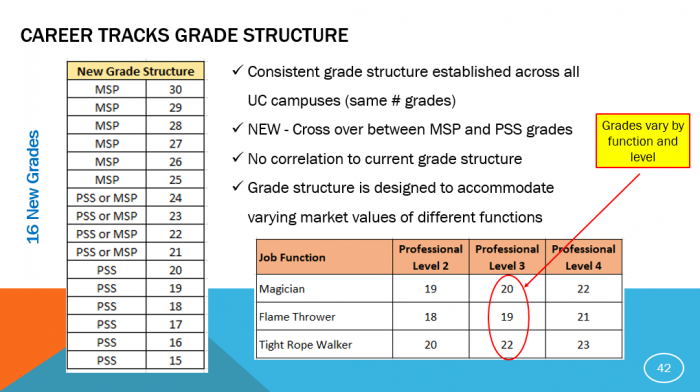
Below is an example of a job structure for the Applications Programming function:
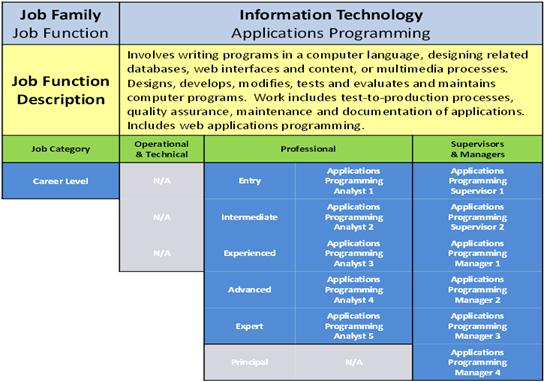
![]()
Job Categories and Levels
CATEGORIES:
There are 4 main Job Categories in the Career Tracks job structure – two within the Individual Contributor series and two within the Leadership series. They are defined as follows:

LEVELS:
Within the Operational/Technical category, there are 3 levels – Levels 1, 2 and 3. These levels are under development and serve as placeholders for future represented positions.
Within the Professional category, there are 5 levels defined as follows:

Within the Supervisor category, there are two levels defined as follows:
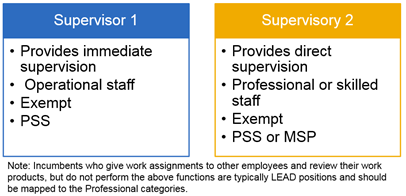
Additional guidance on what qualifies for a supervisory designation can be found under the left bar menu item entitled “Classifying Supervisory and Managerial Positions.”
Within the Manager category, there are 4 levels defined as follows:

Additional guidance on what qualifies for a managerial designation can be found below under “Classifying Supervisory and Managerial Positions.”
![]()
Job Families and Functions
Career Tracks is made up of many different job families and functions. Most are occupationally specific and some are meant to cover a hybrid of functions (when a job covers a blend of functions that make it difficult to classify under one specific function – see the “Classifying Hybrid Positions” section of this site). Below is an example of two different job families and the various functions that exist within those job families. As you can see, there is a “hybrid” function under each of the two examples presented – HR Generalist and Information Systems. This is not uncommon among the various job families available.
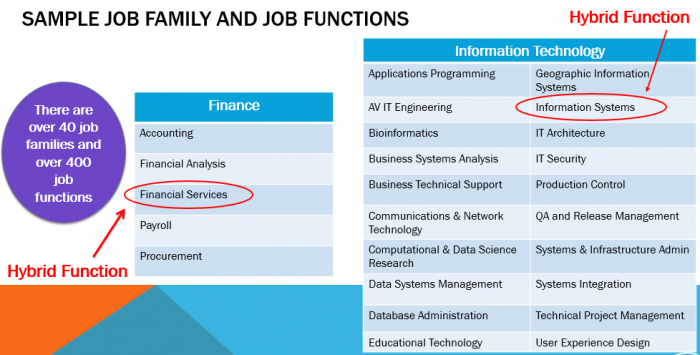
A complete list of job families, functions and job standards can be found on the Career Tracks SharePoint site (see Useful Links box on main Career Tracks page).
![]()
Career Path and Progression
Positions in Career Tracks follow one of two tracks – the Professional/Technical Track (a.k.a. the Individual Contributor track) and the Leadership Track. The diagram below demonstrates how an employee may promote through their career, and that following a professional track can yield similar compensation and classification levels as the leadership track.
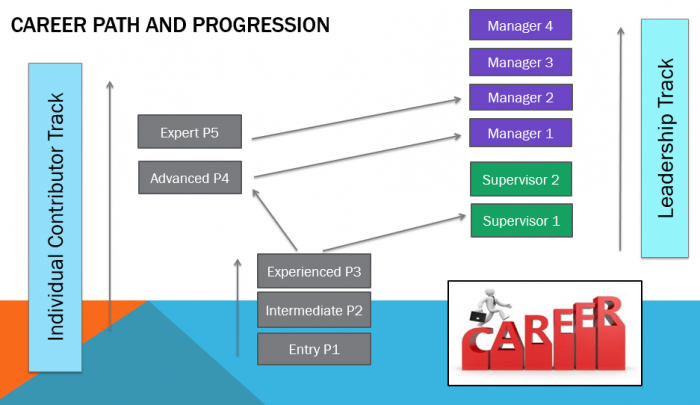
![]()
Classifying Supervisory and Managerial Positions
SUPERVISORS
In Career Tracks, a supervisory title is only assigned when supervision is the primary function and the supervisor spends the majority of his/her time on supervisory related duties.* If 50% or more of the position is focused on performing one or more professional functions and not on supervision, then the position should be classified in the professional track, based on the majority of professional level work performed.
The minimum requirements of a supervisor include the responsibility for independently performing 3 or more of the following HEERA designated supervisory functions for 2.0 or more career FTE:
- Hiring - Independently selects subordinates OR participates in the interviews and recommends who should be hired.
- Performance Evaluations - Independently determines subordinates’ performance ratings OR recommends performance ratings.
- Reclassification/Promotion - Independently decides within budgetary limitations the amount of subordinate merit increases, who will be selected for promotional opportunities, and whether to request the reclassification of a position, OR recommends these actions.
- Discipline/Discharge - Has independent authority to issue written warnings and suspensions and determines what discipline should be imposed upon a subordinate OR recommends such actions.
- Complaint/Grievance Resolutions - Has independent authority to resolve grievances or complaints OR formulates and recommends a resolution to grievances or complaints.
- Work Assignments – Has independent responsibility to assign and determine work assignments.
*Represented employees who supervise 2.0 or more career FTE and spend less than 50% of their time on supervisory related duties may be eligible to be classified as supervisors under Career Tracks and require consultation with Compensation prior to submitting a request.
There are two levels of supervisor – Level 1 and Level 2:
SUPERVISOR LEVEL 1: Provides immediate supervision to a unit or group of operational or technical employees (typically represented employees in support, operational, technical and semi-skilled positions). A portion of time may be spent performing individual tasks related to the unit; however, supervisory activities must constitute a primary part of the job. Supervises unit operations to ensure compliance with departmental or campus policies, procedures, and defined internal controls. Ensures accountability and stewardship of campus resources (operational, financial, and human) in compliance with departmental standards and procedures.
If less than 50% of time is spent on supervisory related duties, then they should be classified according to the function and level of professional work they perform. They can still perform supervisory duties without the designation in their payroll title.
SUPERVISOR LEVEL 2: Provides direct supervision typically to professionals or skilled technical employees. Functions as advisor to unit and administration. Analyzes and resolves problems, interprets policies (e.g., fiscal management, HR, contracts and grants, resource management in defined areas) and demonstrates solid subject matter knowledge. Exercises judgment within defined procedures and policies to determine appropriate action. Supervises staff to assure accountability and stewardship of campus resources (operational, financial, and human) in compliance with departmental goals and objectives.
If less than 50% of time is spent on supervisory related duties, then they should be classified according to the function and level of professional work they perform.
Note: Incumbents who assign work to other employees and review their work products, but do not perform the above functions are typically LEAD positions and should be mapped to the Professional or Operational & Technical categories.
MANAGERS
In Career Tracks, a managerial title is only assigned when supervision and management is the primary function and the manager spends the majority of his/her time on supervisory and management related duties. If 50% or more of the position is focused on performing one or more professional functions and not on supervision and management, then the position should be classified in the professional track, based on the majority of professional level work performed.
An incumbent in a managerial position, in addition to the supervisory functions described above, spends the majority of time (50% or more) achieving organizational objectives through the coordinated achievements of subordinate staff who report to the incumbent, through the performance of the following managerial functions:
- Assumes accountability for decisions made by subordinates
- Manages employee performance (for example, guides, coaches and disciplines staff)
- Manages workflow, operations, apportioning the work
- Establishes department goals and objectives (and manages department progress toward goals)
- Determines techniques and processes
- Plans and oversees the budget
- Monitors or implements legal or policy compliance measures
- Performs strategic planning for function
There are 4 levels of manager – Levels 1 to 4:
MANAGER LEVEL 1: Spends the majority of time (50% or more) achieving organizational objectives through the coordinated achievements of subordinate staff. Establishes departmental goals and objectives, functions with autonomy. Manages the accountability and stewardship of human, financial, and often physical resources in compliance with departmental and campuswide goals and objectives. Ensures subordinate supervisors and professionals adhere to defined internal controls. Manages systems and procedures to protect departmental assets. May report to a Chair, Organized Research Unit Director, or equivalent administrative management.
MANAGER LEVEL 2: Oversees through subordinate Managers a large department or multiple smaller units. Has significant responsibility to achieve broadly stated goals through subordinate Managers. Determines objectives, directs programs, develops strategies and policies, manages human, financial, and physical resources, and functions with a high degree of autonomy. Proactively assesses risk to establish systems and procedures to protect organizational assets. Determines campus strategies for a program with campuswide impact. May report to an Assistant Vice Chancellor or Dean.
MANAGER LEVEL 3: Oversees through subordinate Managers a large, complex organization with multiple functional disciplines/occupations, OR manages a program, regardless of size, that has critical impact upon the campus. Has significant responsibility for formulating and administering policies and programs, manages significant human, financial, and physical resources, and functions with a very high degree of autonomy. Oversees through subordinate Managers the accountability and stewardship of campus resources and the development of systems and procedures to protect organizational assets. Reports to an Associate/Assistant Vice Chancellor, Vice Chancellor, or Dean.
MANAGER LEVEL 4: Directs through subordinate Managers multiple large and complex critical programs impacting broad constituencies across major portions of campus. Identifies objectives, manages very significant human, financial, and physical resources, and functions with an extremely high degree of autonomy. Accountable for formulating and administering policies and programs for major functions. Operational or program results can affect overall campuswide performance and reputation. Directs through subordinate Managers the development of strategic goals and objectives to achieve accountability and stewardship of university resources in a manner consistent with campus and systemwide objectives and initiatives. Usually reports to one of the following: Vice Chancellor or Vice Provost.
![]()
Classifying Hybrid Positions
Many employees at UC wear multiple hats and perform duties that span a variety of functional occupations (i.e. finance, payroll, facilities, student affairs). When in doubt, match a hybrid position to a function based on the duties that:
- Constitute at least 50% of the job
- Constitute the greatest overall percentage of the job
- Would be emphasized for recruiting when a vacancy arises
- Are captured in a “multi-functional” job family (ex: “Information Systems” in IT job family, or “HR Generalist” in HR job family)
![]()
Professional Level 1 - Training Positions
The Professional Series Level 1 (P1) is available as a short-term training position whereby departments may hire entry-level professionals with limited prior experience with the expectation that they will acquire the skills and knowledge necessary to perform more advanced work following an agreed upon time in position, through a defined training and development plan. These positions are restricted to Limited appointments, or probationary Career appointments. P1 Career positions are expected to advance to the P2 level within 6-18 months of hire, once all training goals have been met. Completion of an Individual Development Plan (IDP) is required, providing clear training milestones for the employee to learn and demonstrate essential proficiencies required for the job.
Job Descriptions
All P1 job descriptions must include a statement in the Special Conditions of Employment section clearly identifying the training provided and the proficiency goals required to meet the P2 level within a defined period of time. Example: “The incumbent of this P1 position is expected to acquire the skills and knowledge to perform P2-level work following an agreed upon time (up to 18 months) in the position, through a defined training and development plan.”
Individual Development Plans (IDPs):
At the time of hire, an Individual Development Plan outlining the training plans, learning goals, proficiency expectations, and timeline for meeting goals should be provided to the employee. A signed IDP form must be submitted to HR/Compensation within 30 days of new hire’s start date.
Individual Development Plans are a guide to be leveraged throughout the P1 appointment to monitor training progress and identify proficiencies required for advancement to the P2 level IDP documents should contain:
- Short-term goals to evaluate if training goals are being met during the probationary period.
- Long-term goals to evaluate if proficiencies are being met to advance to the P2 level.
- Descriptions of development activities, expected outcomes, target dates, and ongoing progress / status checks.
Check Points
- Regular meetings between the supervisor / manager and the employee are necessary, with formal check points at the 3, 6, 9, 12, and 18 month marks to assess performance, provide feedback, identify when goals are being met, address any deficiencies, and adjust any training plans as necessary. The following is a recommended timeline:
|
|
|
|
|
|
|
|
|
|
|
|
| If probation was extended, PRIOR TO THE 9 MONTH MARK, dept assesses whether to release employee during probation (by working with ELR) or if the employee is now meeting training goals and will be able to gain the needed P2 proficiencies; P1 position continues on. | ||
|
|
|
|
|
|
Completion of Training period
- Completion of the training period does not trigger auto-reclassification to the P2 level. Once the training period has ended and all P2 proficiencies have been met, the department must submit a reclassification request via Job Builder.
- Advancement to the P2-level is not guaranteed, but will be determined on a case by case basis during the reclassification review.
- The effective date of an approved reclass will be the first day of the pay period following receipt of a complete request.
- The final IDP form from the conclusion of the training period should be uploaded to the reclassification action in Job Builder, as part of the reclass request.
For any questions regarding the use of a Professional 1 title or creating an IDP, please consult with your Compensation Analyst.